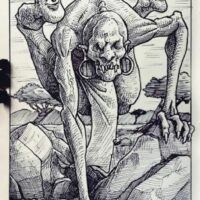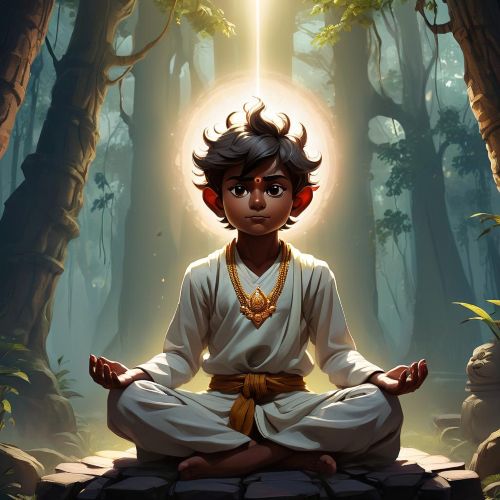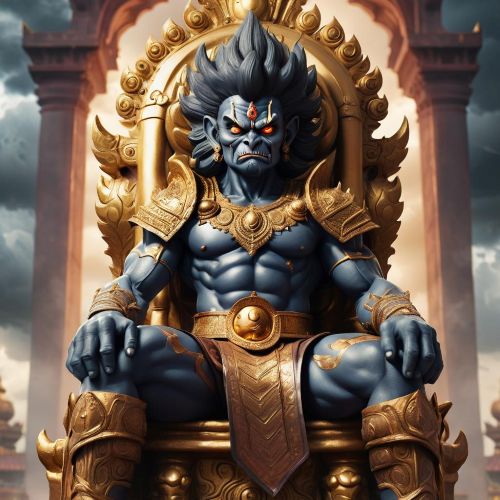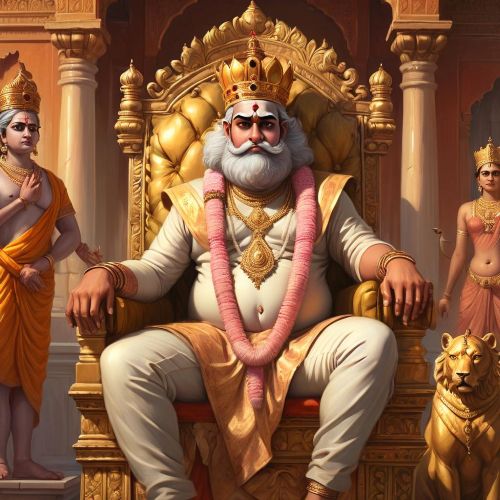Mahabali : The Asura King
Listen
At a glance
| Description | |
|---|---|
| Origin | Indian Mythology |
| Classification | Mortals |
| Family Members | Prahalad (Grandfather), Virochana (Father), Vishalakshi (Mother), Vindhyavali (Wife) |
| Region | India |
| Associated With | Royalty, Kindness, Righteousness |
Mahabali
Introduction
Mahabali, also called Bali, Indrasenan, or Māveli, is one of the most beloved figures in Hindu mythology. Revered as a noble and generous ruler, Mahabali is celebrated for his just governance, humility, and devotion to dharma. Unlike many other asura kings depicted as arrogant or tyrannical, Mahabali is remembered as a ruler who placed the welfare of his people above personal power. His story, immortalized in the Vamana avatar episode of Lord Vishnu, is at the heart of Kerala’s grand harvest festival, Onam, when it is believed he visits his subjects each year. This tale, preserved in ancient scriptures such as the Bhagavata Purana, Vamana Purana, and Mahabharata, transcends religious boundaries, making Mahabali a cultural icon across several Indian states.
Physical Traits
While ancient scriptures focus more on Mahabali’s character than his physical form, later artistic traditions have shaped his visual identity. In Kerala’s popular culture, he is often portrayed as a regal figure, wearing silk garments, a crown, and gold ornaments, with a palm-leaf umbrella symbolizing humility despite his royal stature. However, historical and cultural discourse has challenged the long-standing fair-skinned, potbellied portrayal, noting that as a Dravidian king, he may have been dark-skinned and robust. Sculptures from sites like Badami caves show him as tall, handsome, and well-built, radiating an aura of strength and generosity. Modern reinterpretations, especially in Kerala’s art scene, are moving toward depicting Mahabali with features more in line with his probable cultural heritage, moving away from the comic or exaggerated versions often seen in advertisements.
Family
Mahabali’s ancestry reflects a blend of asura valor and deep spiritual devotion. He was the son of King Virochana and Queen Vishalakshi (or Devamba in some accounts), and the grandson of Prahlada, the legendary devotee of Lord Vishnu. This lineage connects him to the sage Kashyapa, one of the most respected seers in Hindu tradition. Mahabali’s queen, Vindhyavali, stood by him as an equal in wisdom and compassion. Together, they had a large royal family, including 100 sons such as the famed Banasura, a devoted follower of Lord Shiva, and daughters like Ratnamala and Vajrajvala, the latter married to Kumbhakarna of the Ramayana. His brother Kalanemi also features in mythological narratives, further anchoring Mahabali in the wider tapestry of Hindu epics.
Other names
Throughout history and across regions, Mahabali has been known by several names that reflect his diverse legacy. In much of India, he is simply “Bali,” a name that denotes strength and greatness. The epithet Indrasenan hints at his defiance and eventual victory over Indra, king of the devas. In Kerala, especially during Onam, he is affectionately called Maveli, a form that conveys closeness and endearment. Beyond India, in Thailand and among Tai traditions, he is venerated as Chao Krung Bhali, a guardian figure associated with protection and prosperity. Each of these names encapsulates a different aspect of his identity—as a warrior, king, cultural hero, and symbol of moral integrity.
Powers and Abilities
Mahabali’s rule over the three worlds—earth, heaven, and the underworld—was not won by brute force alone but by a combination of valor, discipline, and dharmic governance. Through intense penance and virtuous conduct, he acquired powers that made him nearly invincible. His military skill allowed him to defeat Indra and the devas, bringing stability and prosperity to his realm. For a time, he possessed the amrita, granting him immunity from death and the ability to be revived in battle. Legends also speak of his unmatched swordsmanship, mastery over divine weapons, and the strength to endure even Indra’s most powerful lightning strikes. Despite such might, his greatest power lay in his humility—evident when he willingly surrendered his kingdom to Vamana, recognizing the divine will. This selflessness secured him a place among the Chiranjivis, the immortals destined to live until the end of the current cosmic age.
Modern Day Influence
In modern culture, Mahabali’s influence is most visible in Kerala’s Onam festival, a ten-day celebration that blends myth, tradition, and community spirit. The festival welcomes Mahabali back to his kingdom, with people adorning their homes with pookalams (floral designs), preparing the grand vegetarian feast Onasadya, and participating in boat races, folk dances, and other cultural events. This annual return reinforces the values of unity, equality, and prosperity that defined his reign.
Beyond Kerala, his memory is honored in Maharashtra, Karnataka, and other states during Balipratipada or Bali Padyami, celebrated around Diwali, emphasizing his just rule and generosity. Political and social movements in southern India often invoke Mahabali as a symbol of egalitarian governance and Dravidian pride, especially in debates about historical identity and cultural representation. His evolving imagery—from a potbellied, fair-skinned king to a dark-skinned, strong ruler—reflects broader social conversations about reclaiming indigenous heritage.
In art and media, Mahabali’s tale continues to inspire adaptations in literature, theater, murals, and classical dance forms like Kathakali and Mohiniyattam. Internationally, his figure is respected in Southeast Asian traditions, linking him to broader Hindu-Buddhist cultural exchange. Modern interpretations also cast him as a figure of resistance against oppression, drawing parallels between his ousting from the throne and the struggles of marginalized communities today. In everyday Malayali consciousness, he remains both a mythic ruler and a relatable figure—sometimes even likened to the Malayali expatriate working abroad, longing for home yet tied deeply to it.
Mahabali’s story—anchored in themes of sacrifice, justice, and humility—remains a timeless reminder that true greatness lies not in holding power, but in knowing when to give it up for a greater good. This enduring relevance ensures that Mahabali is not just a figure of the past but a living part of India’s cultural and ethical imagination.
Related Images
Source
“Aigamuxa.” Mythologyleth, https://en.wikipedia.org/wiki/Aigamuxa. Accessed 15 August 2024.
“Aigamuxa.” Creatures of Myth and Legend, https://en.wikipedia.org/wiki/Aigamuxa. Accessed 15 August 2024.
Allen, Peter J., Saunders, Chas. (2018, November 1). AIGAMUXA – the Khoikhoi Demons (African mythology). Godchecker.com
Aigamuxa. (2023, April 30). Mythical Creatures & Beasts. mythicalcreaturesandbeasts.com
Aigamuxa. (n.d.). Cryptid Wiki. fandom.com
Aigamuxa. (n.d.). Myth and Folklore Wiki. fandom.com
Aigamuxa. (n.d.). Oxford Reference. oxfordreference.com
Frequently Asked Questions
What is lorem Ipsum?
I am text block. Click edit button to change this text. Lorem ipsum dolor sit amet, consectetur adipiscing elit. Ut elit tellus, luctus nec ullamcorper mattis, pulvinar dapibus leo.
What is lorem Ipsum?
I am text block. Click edit button to change this text. Lorem ipsum dolor sit amet, consectetur adipiscing elit. Ut elit tellus, luctus nec ullamcorper mattis, pulvinar dapibus leo.
What is lorem Ipsum?
I am text block. Click edit button to change this text. Lorem ipsum dolor sit amet, consectetur adipiscing elit. Ut elit tellus, luctus nec ullamcorper mattis, pulvinar dapibus leo.
What is lorem Ipsum?
I am text block. Click edit button to change this text. Lorem ipsum dolor sit amet, consectetur adipiscing elit. Ut elit tellus, luctus nec ullamcorper mattis, pulvinar dapibus leo.
What is lorem Ipsum?
I am text block. Click edit button to change this text. Lorem ipsum dolor sit amet, consectetur adipiscing elit. Ut elit tellus, luctus nec ullamcorper mattis, pulvinar dapibus leo.













